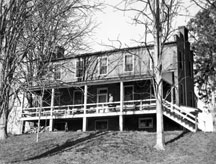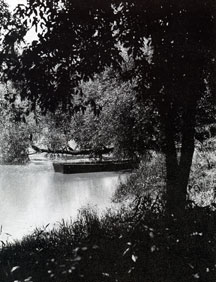What recreation area owned by James Madison University have students and faculty visited for the last 75 years to enjoy the outdoors?
It's not the Edith J. Carrier Arboretum – that opened in 1988. It's University Farm: 31 scenic acres alongside the North River has been used primarily by faculty, staff and student organizations. (The North River merges with the South River just beyond the farm to become the South Fork of the Shenandoah River.)
The land for the farm, about 10 miles east of campus off Virginia 276, was purchased from Grover S. and Anna M. Hooke by the State Teachers College at Harrisonburg (predecessor to the modern day JMU) in August, 1929. In the pre-inflation days of the late 1920s, the sale price was a mere $4,750.
 |
|---|
|
The old farmhouse at the University Farm
|
The land was renamed College Camp. The large brick house on the property was split up for student accommodations – the first floor was reserved for seniors and sophomores and the second floor for juniors and freshmen.
The first weekend retreat was held at College Camp in the spring of 1930. The 25 campers, which was the limit on camp attendees, had to be accompanied by a chaperon – the standard rule for young women college students in the first half of the 20th Century.
Among the regulations for those using the College Camp was Rule No. 9: “No card playing or dancing is allowed at the camp on Sunday.”
There were also stringent rules on visitors coming to the camp and on swimming or boating in the North River.
 |
|---|
| The boat "Speedy" in the North River at the College Camp in 1930 |
The May 24, 1930, issue of The Breeze reported, with unrestrained glee, that “the long looked-for boat has at last come to the school camp which recently opened.” The boat, named “Speedy,” had been given to the campus by the school's Athletic Association.
The College Camp was shut down for a few years during World War II, but otherwise remained very popular throughout the 1930s and 1940s.
In his authoritative history of Madison College, the late Raymond Dingledine, Jr. described a typical, idyllic weekend at College Camp as “cooking on a wood range, washing at a pump, talking and singing around an open fire until long after midnight, and hiking along the river in the quiet of a Sunday morning.”
In the 1950s and 1960s, the camp “wasn't kept up real well,” Dingledine said in a 1980 interview. Consequently, attendance dropped.
Dingledine also attributed the College Camp's dwindling popularity to the new-found mobility of students in those decades. “They were able to get home or get away for the weekend.” During this time the camp's name was changed to College Farm.
The 1970s saw a resurgence of interest in the farm. Because the farmhouse had deteriorated past hope for affordable repair, its use was prohibited and a pavilion was constructed in 1976.
When Madison College was changed to James Madison University in 1977, College Farm was renamed University Farm. Although use is not as widespread as it was in the 1970s and 1980s, the farm remains popular today.
The farm's bucolic location adjacent to the North River usually provides a tranquil and peaceful setting. However, in the early November, 1985, five straight days of heavy rain caused widespread flooding and massive destruction through Rockingham County and other parts of the Shenandoah Valley.
The normally-peaceful North River overflowed its banks, with flood waters reaching the farmhouse – several hundred feet from the river. Water extended beyond the pavilion and, at its highest point, rose to the pavilion roof.
--August Smith
